Lori Robinson's Blog, page 2
August 7, 2025
Thinking About An African Safari?
There’s something about the words African Safari that stirs the soul. Maybe it’s the call of lions across a savannah at dawn. Or the idea of being completely unplugged, out where the wild things are. But when it comes to actually planning a safari in Africa, most people have a flood of questions — and not just about which animals they’ll see.
After spending over three decades exploring Africa’s wildest corners — sometimes leading clients, and other times with my wild heart — I’ve learned a few things. Here’s what people most often want to know before booking their first (or fifth!) safari.
Where Should I Go?Africa is vast and incredibly diverse. Kenya and Tanzania are famous for the Great Migration, while Botswana offers luxury in remote wilderness. South Africa is great for honeymooners and first-timers with its well-developed parks and malaria-free zones. Uganda and Rwanda are for gorilla trekking. Namibia is pure desert magic.
Pro tip: It’s not about “the best place.” It’s about the kind of experience you want — epic migrations, luxury lodges, raw adventure, or quiet solitude. Book a one-hour consult with me to help you figure out where and when to get the experience you imagine. https://savingwild.com/life-changing-african-safaris/
What Animals Will I See?Yes, the Big Five — lion, leopard, elephant, rhino, and buffalo — are on most people’s lists. But you might also see cheetahs, wild dogs, zebras, giraffes, hippos, and thousands of birds. Sometimes, it’s the unexpected moments that stay with you — like a baby elephant playing with its trunk or the stillness before a lion roars.
What Kind of Safari is Right for Me?– Guided game drives: the most common and comfortable.
– Walking safaris: for those who want to feel the earth beneath their feet.
– Boat safaris: unforgettable in places like Botswana or Zambia.
– Mobile tented camps: sleep under canvas, wake up with the wild.
Your comfort level matters — whether you’re craving luxury or don’t mind brushing your teeth next to a warthog.
What Do I Pack?Think layers, earth tones, and comfort. Morning drives are cold; midday gets hot. You’ll want binoculars, a good camera if you have one, a hat, sunscreen, and insect repellent. Leave the bright colors, loud zippers, and fancy shoes at home.
What Does It Cost?Safaris range from budget to ultra-luxury. A basic camping safari in Tanzania might cost $150/day, while a luxury lodge in Botswana could set you back $1,500+/night. But don’t let sticker shock stop you — there are options for every kind of traveler.
Is It Safe?This is the question I get especially from solo women travelers. The answer: yes, if you go with a reputable guide or company. Wild animals aren’t out to get you, but they are… wild. Listen to your guide, don’t wander off alone, and you’ll be just fine.
Is It Ethical?A safari can support conservation and local communities — or do harm, depending on who you book with. Look for lodges and operators who give back, employ local staff, and follow ethical wildlife practices (no petting lions or riding elephants, please). I’m happy to recommend ethical operators. https://savingwild.com/life-changing-african-safaris/
What Will It Feel Like?A safari can crack you open. It’s dusty, unpredictable, and often emotionally overwhelming. You might cry watching elephants move silently through golden grass, or feel something ancient stir when you lock eyes with a lion. Great African Safaris are journeys — pilgrimages back to something wild within you.
Want to See and Hear More?I’ve filmed many of these moments — the stunning, the strange, the spiritual — and shared answers to even more of your burning safari questions on my YouTube channel.
Come explore: https://www.youtube.com/@LoriSavingWild
I’ll take you behind the scenes, show you what a safari looks and feels like, and help you prepare for the journey of a lifetime.
Final ThoughtYou don’t go on safari to check off animals. You go to remember that you, too, are part of this wild world. That somewhere, deep beneath the layers of daily life, something in you still belongs to the open sky and the sound of hooves pounding the earth.
Africa is calling.
Are you ready?
Avoid hours searching through the internet. Book a one-hour consult with me by phone where I answer all your questions and help you focus on where, and when to create the african safari you are dreaming of.
The post Thinking About An African Safari? appeared first on Saving Wild.
Thinking About an African Safari? Here’s What You Really ...
There’s something about the words African Safari that stirs the soul. Maybe it’s the call of lions across a savannah at dawn. Or the idea of being completely unplugged, out where the wild things are. But when it comes to actually planning a safari in Africa, most people have a flood of questions — and not just about which animals they’ll see.
After spending over three decades exploring Africa’s wildest corners — sometimes leading clients, and other times with my wild heart — I’ve learned a few things. Here’s what people most often want to know before booking their first (or fifth!) safari.
Where Should I Go?Africa is vast and incredibly diverse. Kenya and Tanzania are famous for the Great Migration, while Botswana offers luxury in remote wilderness. South Africa is great for honeymooners and first-timers with its well-developed parks and malaria-free zones. Uganda and Rwanda are for gorilla trekking. Namibia is pure desert magic.
Pro tip: It’s not about “the best place.” It’s about the kind of experience you want — epic migrations, luxury lodges, raw adventure, or quiet solitude. Book a one-hour consult with me to help you figure out where and when to get the experience you imagine. https://savingwild.com/life-changing-african-safaris/
What Animals Will I See?Yes, the Big Five — lion, leopard, elephant, rhino, and buffalo — are on most people’s lists. But you might also see cheetahs, wild dogs, zebras, giraffes, hippos, and thousands of birds. Sometimes, it’s the unexpected moments that stay with you — like a baby elephant playing with its trunk or the stillness before a lion roars.
What Kind of Safari is Right for Me?– Guided game drives: the most common and comfortable.
– Walking safaris: for those who want to feel the earth beneath their feet.
– Boat safaris: unforgettable in places like Botswana or Zambia.
– Mobile tented camps: sleep under canvas, wake up with the wild.
Your comfort level matters — whether you’re craving luxury or don’t mind brushing your teeth next to a warthog.
What Do I Pack?Think layers, earth tones, and comfort. Morning drives are cold; midday gets hot. You’ll want binoculars, a good camera if you have one, a hat, sunscreen, and insect repellent. Leave the bright colors, loud zippers, and fancy shoes at home.
What Does It Cost?Safaris range from budget to ultra-luxury. A basic camping safari in Tanzania might cost $150/day, while a luxury lodge in Botswana could set you back $1,500+/night. But don’t let sticker shock stop you — there are options for every kind of traveler.
Is It Safe?This is the question I get especially from solo women travelers. The answer: yes, if you go with a reputable guide or company. Wild animals aren’t out to get you, but they are… wild. Listen to your guide, don’t wander off alone, and you’ll be just fine.
Is It Ethical?A safari can support conservation and local communities — or do harm, depending on who you book with. Look for lodges and operators who give back, employ local staff, and follow ethical wildlife practices (no petting lions or riding elephants, please). I’m happy to recommend ethical operators. https://savingwild.com/life-changing-african-safaris/
What Will It Feel Like?A safari can crack you open. It’s dusty, unpredictable, and often emotionally overwhelming. You might cry watching elephants move silently through golden grass, or feel something ancient stir when you lock eyes with a lion. Great African Safaris are journeys — pilgrimages back to something wild within you.
Want to See and Hear More?I’ve filmed many of these moments — the stunning, the strange, the spiritual — and shared answers to even more of your burning safari questions on my YouTube channel.
Come explore: https://www.youtube.com/@LoriSavingWild
I’ll take you behind the scenes, show you what a safari looks and feels like, and help you prepare for the journey of a lifetime.
Final ThoughtYou don’t go on safari to check off animals. You go to remember that you, too, are part of this wild world. That somewhere, deep beneath the layers of daily life, something in you still belongs to the open sky and the sound of hooves pounding the earth.
Africa is calling.
Are you ready?
Avoid hours searching through the internet. Book a one-hour consult with me by phone where I answer all your questions and help you focus on where, and when to create the african safari you are dreaming of.
The post appeared first on Saving Wild.
March 18, 2025
My Grandfather ‘Delivered’ Jane Goodall
On an April day in 1934 a new mother was discharged from a London maternity home, along with her baby girl. Deeming her husband’s Aston Martin race- car too dangerous to transport their firstborn, she enlisted the help of a friend, the owner of a more sedate vehicle. It was my grandfather, Denis Robinson, who conveyed them safely home that day, an act emblematic of their friendship. But no one could have predicted that the baby clasped so carefully in her mother’s arms in Grandpa’s back seat, Valerie Jane Morris-Goodall, would grow up to be one of the world’s most famous conservationists.
Jane Goodall skyrocketed to fame at 29 in the August 1963 issue of National Geographic, captivating readers with her feature article, “My Life Among Wild Chimpanzees.” I was only a few years old at the time. But as a teenager, I occasionally accompanied my grandfather to functions honoring “Dr. Jane,” and like many women in my Baby Boomer generation, I idolized the courageous young British scientist living in the African bush.
Later, after my grandfather died, I spent several years working as the African Adventures Specialist for the Jane Goodall Institute leading their high-level donors on safari in East Africa. And, it was a conversation with Dr. Jane, at one of her birthday parties several years ago, that planted the seed for my book, Saving Wild: Inspiration From 50 Leading Conservationists.
Dr. Jane has been my mentor as long as I can remember. And I’m happy to honor her every April 3rd for yet another lap around the sun and all the work she continues to do to save the wild places and wild beings of this world.
Happy Birthday Jane. I love you, and my grandfather did as well.
The post My Grandfather ‘Delivered’ Jane Goodall appeared first on Saving Wild.
January 24, 2024
Lori Robinson Interview
Moving At the Speed of Nature {Interview with Lori Robinson by Katherine Sanders}
I sat with Lori Robinson on the Caretaker’s Cottage deck, situated just below the Garden Nursery at Santa Barbara Botanic Garden, the morning sun peeking between the leaves of red grape (Vitis ‘Roger’s Red) climbing the trellis over our heads. It was the perfect setting to get to know Lori, an author, a safari specialist, a self-proclaimed “wild keeper,” and, more recently, a volunteer docent at the Garden.
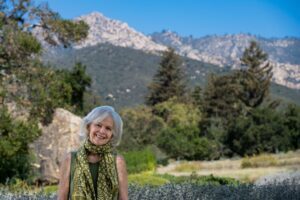 Lori Robinson
Lori RobinsonA Heart for California
Growing up a total animal lover – idolizing Jane Goodall in a goats-and-raccoons-and-alligators-as- pets kind of family – inspired Lori’s broader love of the natural world. “I’ve always wanted to help wild places and wild animals,” she recounts. Even though Lori was raised in Florida, her story is deeply intertwined with California and its landscape. “I was supposed to be born in California,” Lori beams. “My parents met at Stanford. They were married, and then they got pregnant with me, flew to Florida, and never came back. So, I was born there, but California is in my genes. I always knew I was going to come back here.” A hawk calls in the distance, punctuating Lori’s sentiment.
Lori first moved to California to study at the University of California, Santa Cruz, majoring in environmental studies and biology. After graduating, she left the state to work for the Animal Welfare Institute in Washington, D.C. She began writing about whaling issues, factory farming, and animal experimentation and testing. The work wore on her though, and she found herself hopeless and distraught by the weight of these issues. “At the time, I believed I was too sensitive to endure the work,” Lori admits, “but in time I saw that I was just young, impatient, and naïve about how long it takes to create change.”
Falling in Love with Native Plants
Lori eventually found her way back to California and this time to Santa Barbara. After buying a home, she connected with the Garden and started taking gardening classes. It wasn’t long before she realized her home garden could be more than beautiful. It could make a real difference. “I learned about the
benefits of planting with native plants and it became such a passion of mine. We can all grow native plants to help ‘save wildness’.
Let Nature Set the Pace
This notion steered Lori in a different direction than her time in D.C. had. “We can all have a patch of the Garden at home, even if it’s just a native plant on our patio.” She acknowledged the sometimes- paralyzing feeling people face when trying to decide what, where, or how to start planting native plants, but, she continued, “Gardening at home gives me a sense of control. It makes me feel like I can do something instead of [single-handedly] stopping climate change and a potential sixth mass extinction, which feel so big I don’t know where to start.” She explained Douglas Tallamy’s newest book, “Nature’s Best Hope,” which is about this exact concept. Lori expressed a sense of hope about Tallamy’s message.
“Can you imagine if we all filled our gardens with even a few native plants? It would create a little ecosystem route for native pollinators to follow!” Taking even small steps like these offers a tangible solution to the complex and abstract challenges we
face with the climate and biodiversity crises. For many though, this action may seem too small and the fact that natural processes don’t have immediate results only heightens their indecision. “The barrier to entry is low though,” Lori stressed. “You just need to start with one plant.” And though it takes a few seasons for plants to establish themselves, she explained, “You have to be brave enough and patient enough to let the system start to work in its natural way.” It’s sage advice that’s evident all around the Garden.
Finding Nature Everywhere
Some years ago, Lori started leading safari tours in Africa as part of the Jane Goodall Institute.
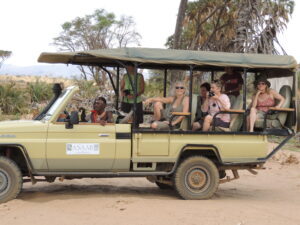
“Everything in Africa is so big. The spaces, the trees, the animals. It’s incredible,” she waved her arms to emphasize. “People go to Africa and they say, ‘Oh my gosh, the animals!’ and honestly, we’ve got them [here in Santa Barbara] too, but they just look different.” We often consider our wild animals – skunks, raccoons,
opossums – pests more than majestic creatures. “You can’t say, I’ don’t like skunks,’ but like birds. They all kind of work together and rely on each other,” Lori illustrated. This thinking aligns with the Garden’s mission to conserve native plants because they, in turn, sustain all life on Earth. In leading safaris, Lori noticed people have a way of thinking they need to “go to nature,” but she emphasized that nature is everywhere. “Try going outside your door and allow for the same kind of openness you’d have when you go on a hike. That same feeling can be found right on your patio with a little care.” Lori had been learning recently about the idea of a sit spot, which inspired her to start her practice. “I sit outside with a cup of tea every morning. The key is to have a spot you can go to every single day for the same amount of time. It helps create the familiarity and the patience to notice things, big and small.”
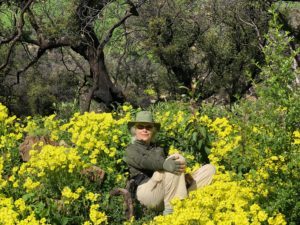 Find native plant inspiration for your garden along your local hiking trails.
Find native plant inspiration for your garden along your local hiking trails.The Feeling of Home
The appreciation for California as a biodiversity hot spot was always in Lori’s sight line, and now not only does she live here, but she gets to spread her joy and respect for nature as well. “I love this place,” exclaimed Lori about the Garden, “and now, being a docent, I’m able to encourage people to plant with native plants.” She noted that people make mistakes “like spraying, cutting down, planting the wrong things.” But we can course correct. The Garden is a great teacher in that regard. As Lori encouraged, we need to plant natives and then “slow down to let nature do its thing.”
The post Lori Robinson Interview appeared first on Saving Wild.
December 1, 2023
Donating for Wildlife: What you Need to Know
I have a Senegalese friend who now lives in the USA working as an African drummer. Every morning Bara walks along the streets of Los Angeles purposely seeking a homeless person. When he finds that person, Bara reaches into his own pocket and hands out one of the few dollars he possesses.
When I ask Bara, “Why do you do that every day?” his answer is simple.
“I have to,” he says.
Tithing or sharing the ‘wealth’ (even when you are not wealthy) is a cultural expectation among everyone I have ever known from Africa.
Americans are also generous. We are one of the most philanthropic of all nations. That’s a great thing but what I find surprising is most of the money given to charity does not come from the people who have the most wealth.
My friend Lynn Twist, author of The Soul of Money would not be surprised by Bara’s actions. She says that the majority of the donations come in small amounts – one, ten, fifty dollars – from people with the least amount of wealth because giving, on any level, feels good.
Another surprising fact is only 2 cents of every American donor’s dollar goes to donating to animal charities. This tiny amount includes gifts to humane societies, zoos and climate change organizations.
Yet now, more than ever, our generosity is required by organizations saving wildlife and wild places. Scientists say we are entering the sixth mass extinction event, losing more species at a faster rate than at any time in human history. (That fact was the catalyst for my both my books – Saving Wild: Inspiration From 50 Leading Conservationists. and Wild Lives.
In the forty-plus years I’ve been working with wildlife non-governmental organizations I’ve never experienced such an important and pressing time for donating to animal charities.
Donating to Animal Charities is not always effective.
For instance, how do you know which organizations you donate to are successful in saving wildlife? How do you know they aren’t wasting your money? Charity Navigator tells only part of the story of the organizations it covers, and those organizations are based only in the USA.
I’ve made it easy for you for donating to animal charities by finding some of the best, most effective non-government organizations (NGO’s).
You can check out my list of my favorite 40 organizations saving wildlife and wild places across the world. All are highly respected NGO’s in their field. Many I have worked with, and donated to personally and/or through Saving Wild.
Never doubt that you are needed. It’s not enough to share shocking Facebook photos. They fuel the appalling side of conservation. Rather, it’s important to focus on the positives. To get engaged. To support wildlife NGO’s by donating and becoming active and involved with them.
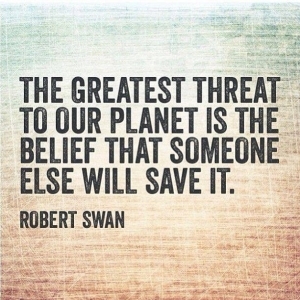
The simplest way of donating to animal charities –
Let SavingWild vet the organizations for you and put your generous gifts where they are needed most.
Donate to SavingWild.com and I will pool your money with other generous donors and divide it among favorite wildlife NGO’s that are the best at helping animals.
No amount is too small. Give yourself the gift of giving and quit wasting your generosity.
Donating to Animal Charities could not be easier. Use this link to make your donation through SavingWild now:

The post Donating for Wildlife: What you Need to Know appeared first on Saving Wild.
November 30, 2023
Best NGOs For Wildlife, Part 2
My list of the best 30 NGOs working to save wildlife and wildlands all over the world continues. For Part 1 of the best NGOs for wildlife that won’t waste your money, go here.
Many organizations are doing great work saving wildlife and wild places, but I have chosen NGOs I am familiar with, or that I believe deserve more attention for the wonderful work they are doing
Ric O’Barry’s Dolphin Project (Dolphins)
Ric O’Barry’s Dolphin Project (not to be confused with other organizations with a similar name) was founded on Earthday 1970 to stop dolphin slaughter and exploitation around the world after ‘Flipper’ committed suicide in his arms. Ric O’Barry has pioneered the re-adaptation & release of captive dolphins into the wild.
I love this small, relatively new organization transforming the way people relate to whales and dolphins by bringing an end to their exploitation and by creating seaside sanctuaries, assisting with international marine mammal rescues, and advancing whale and dolphin science.
Oceana
The world’s oceans are in trouble, and this organization works with companies and legislators to bring about more sustainable practices for the long-term health of the ocean and its creatures.
Painted Dog Conservation (African Wild Dog)
Painted dogs, or African wild dogs, are among Africa’s most endangered species with only 3,000 – 5,000 left. Zimbabwe is home to one of the last strongholds of the species and PDC works to educate the local communities about the importance and beauty of this iconic species.
**SavingWild.com has partnered with PDC to sponsor school children to go through their Wild School program.
North American Bear Center (Black Bears)
All eight bear species around the world are listed as vulnerable, threatened, or endangered. The Bear Center is dedicated to replacing misconceptions with education and scientific facts to conserve bear habitat, stop poaching for bear body parts, rehabilitate injured and orphaned bears back to the wild, and implement methods to reduce conflict between humans and bears.
Lion Guardians
Engaging local people to mitigate lion-human conflict over a million-acre area surrounding Kenya’s Amboseli National Park. Conflict continues to increase as climate changes and drought push hungry lions into unsafe territories to prey on livestock.
Australian Society for Kangaroos
The Australian Society for Kangaroos works to educate the public about the iconic, cultural, spiritual and economical value of all species of kangaroos and wallabies who are victims of the world’s largest land-based wildlife massacre.
National Audubon Society (Birds)
Audubon’s mission is to conserve and restore natural ecosystems, focusing on birds, other wildlife, and their habitats for the benefit of humanity and the earth’s biological diversity.
Free the Bears (Asian Bears used for Bile Farming)
Started by animal advocate and grandmother Mary Hutton after watching a current affairs TV program in Perth about the bile farms with captive Asiatic bears, the mission of this organization is to protect, preserve, and enrich the lives of bears throughout the world.
Project Coyote works to change negative attitudes toward coyotes, wolves, and other native American carnivores by replacing ignorance and fear with understanding, respect, and appreciation.
CAN’T DECIDE WHICH NGOs FOR WILDLIFE TO GIVE TO?Let us decide. Donate to SavingWild and we will pool your money, with others donations, and my personal $1,500 giving budget to distribute to the organizations with the most need.
NO AMOUNT IS TOO SMALL.
DONATE NOW:

International Anti-Poaching Foundation
The IAPF has a structured approach to conservation, employing the relevant tactics and technology to defend wildlife from the ever-increasing threat of poaching within protected areas. Anti-poaching however is only a portion of the conservation solution. To be a part of successful projects, the IAPF works alongside partners who specialise in community engagement and development, research and development, wildlife rescue and biodiversity management.
Wild Aid (Illegal Wildlife Trade)
Wild Aid is the only organization focused on reducing the demand for wildlife parts and products, with the strong and simple message: when the buying stops, the killing can too. Their mission is to end illegal wildlife trade.
Yellowstone to Yukon Conservation Initiative (Wildlife Corridors)
A joint United States and Canada Initiative, it is recognized as one of the planet’s leading mountain conservation initiatives to preserve and maintain the wildlife, native plants, wilderness and natural processes of the mountainous region from Yellowstone National Park to the Yukon Territory.
Working in Africa, their mission is to find the right formula of conservation, communities and commerce that would make a lasting, sustainable difference to the world’s iconic wildlife and wildernesses.
The Alliance brings its more than 1,100 member land trusts together — and increases each one’s success by advocating for the policies and incentives that it takes to save millions of acres every year.
African Wildlife Conservation Fund
The African Wildlife Conservation Fund promotes the long-term sustainability of healthy wildlife populations via research and educational partnerships with landowners and community members, natural resource managers, conservationists, and governments in Africa.
Wildlife Direct is a Kenya and US registered organization founded and chaired by African conservationist Dr. Richard Leakey, who is credited with putting an end to the elephant slaughter in Kenya in the 1980s. Established in 2006 Wildlife Direct provides support to conservationists in Africa directly on the ground via the use of blogs, which enables anybody, anywhere to play a direct and interactive role in the survival of some of the world’s most precious species.
Based in Britain with twenty-two years experience initiating and funding conservation, community development and environmental education programs across Africa, Tusk has raised over $30 million for a wide range of projects across the African continent. Their annual conservation awards, presented by Prince William, highlight inspirational conservation work in Africa.
A great organization focused on India’s wildlife and wild places by providing reliable information and the tools needed to campaign effectively. They are working to protect elephants, and tigers, as well as fighting against plastic litter.
Note: Charity Navigator provides an important service to donors interested in U.S. charities, but it is unable to capture the entire picture of the work and structure of some international wildlife organizations. Charity Navigator itself states: “We do not recommend using our ratings as the only factor in deciding whether to support a particular organization.”
I hope you are finding these lists of the best NGOs for wildlife helpful when choosing where you can be most effective with your giving. If you missed part 1 check it out now.
Love,
Lori
The post Best NGOs For Wildlife, Part 2 appeared first on Saving Wild.
Best 30 Wildlife Organizations that Won’t Waste Your $$$
In no particular order here are my favorite 30 wildlife organizations that deserve your donation. I update this post throughout the year so check back whenever you are deciding where to give your wildlife donations.
Retiti Elephant SanctuaryI love this sanctuary in the Samburu region of Northern Kenya. Many of Kenya’s orphaned elephants are discovered in this area, so it makes my heart sing knowing these traumatized babies can now be rehabilitated on their birth land rather than flown or trucked to the foreign but more famous elephant orphanage in Nairobi.
Save the ElephantsIain Douglas-Hamilton’s research on wild elephant populations in Northern Kenya has taught the world much about elephant behavior, and migrating patterns. His wildlife organization, ‘Save the Elephants’ is focused on stopping poachers, thwarting traffickers, and ending demand for ivory.
Performing Animal Welfare SocietyPAWS is at the forefront of efforts to rescue and provide appropriate, humane sanctuary for animals who have been the victims of the exotic and performing animal trades. Started by an animal trainer for the movie industry turned animal activist, PAWS focuses on Elephants but has also rescued bears, tigers, monkeys, and other animals from the abusive life of entertainment.
Cheetah Conservation FundDr. Marker’s Cheetah Conservation Fund is a model to other wildlife organizations for her pioneering work engaging communities in Namibia to protect cheetahs.
PantheraDedicated to conserving the world’s 36 species of wild cats including tigers, lions, jaguars, and snow leopards, Panthera partners with local and international scientific institutions, communities, NGO’s, and government agencies.
Small Cat Conservation AllianceThe SCCA works with partners and organizations around the world reducing and mitigating threats to the world’s 31 species of small wild cats.
Established in 1997 by the late Carole Noon and 21 chimpanzees, Save the Chimps has grown to be the world’s largest chimpanzee sanctuary. They provide permanent care for 300 chimpanzees rescued from research laboratories, the entertainment industry, and the pet trade.
Non-Human Rights ProjectThe only organization working toward actual LEGAL rights for non-human species. Their mission: to change the common law status of at least some nonhuman animals from mere “things,” which cannot possess any legal right, to “persons,” who possess such fundamental rights as bodily integrity and bodily liberty. What this organization is fighting for, if achieved, will be a game-changer for animals worldwide.
Great Apes Survival PartnershipGRASP is an innovative and ambitious partnership comprised of great ape range states faced with an immediate challenge: to lift the threat of imminent extinction faced by gorillas, chimpanzees, bonobos, and orangutans across their ranges in Equatorial Africa and Southeast Asia.
Lola ya BonobosLola ya Bonobo is the world’s only organization to provide lifetime care to orphaned bonobos (the least known of the great apes). At the sanctuary, the bonobos recover from the physical and psychological trauma suffered from being torn from their mothers and their natural habitat in The Democratic Republic of Congo – the only country with wild bonobos.
Recommended reading: the delightful memoir, ">Bonobo Handshake, by Vanessa Woods who spent years working at Lola ya Bonobo Sanctuary.
Ngamba IslandThis 100-acre sanctuary in Uganda rescues orphaned and abused chimps from the bushmeat, entertainment, and pet trade industries. Through their ‘adopt a chimp’ program you can support one of the chimps currently living there.
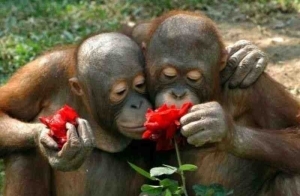 Orphaned orangutans appreciating flowers.
Save The Orangutan
Orphaned orangutans appreciating flowers.
Save The Orangutan
Save the Orangutan has launched a Forest Program to preserve and restore the orangutans’ natural habitat. By supporting SOS Borneo, you help ensure that orangutans can continue to roam freely in the treetops of Borneo.
Center for Biological DiversityBecause the loss of biodiversity impoverishes society, the Center for Biological Diversity uses science, law, and creative media to protect the lands, waters, and climate that all species need to survive. An impressive ninety-three percent of their lawsuits have resulted in favorable outcomes for endangered species.
14. Animal Defenders International
Animal Defenders International (ADI) was founded in 1990. With offices in Los Angeles, London, and Bogota, ADI educates and campaigns across the globe for animals in entertainment and other industries. One of the busiest and most effective organizations I know of but I find their website to be confusing and a turn-off to someone looking to get involved.
International Fund for Animal WelfareWhether it’s working to end whaling, poaching, or seal hunts this organization has no boundaries for its mission to save individual animals, animal populations, and habitats across the world. Founded in 1969, with projects in more than 40 countries including China, IFAW provides hands-on assistance to all animals in need.
Defenders of WildlifeDefenders’ approach is direct and straightforward – they “protect and restore imperiled species throughout North America by transforming policies and institutions and promoting innovative solutions” –making a lasting difference for wildlife and its habitats.
Born FreeBorn Free takes ‘front line’ action worldwide, sending emergency teams to rescue vulnerable animals from appalling lives of misery in tiny cages and move them to spacious bush sanctuaries.
PetaPeta’s statement “Animals are not ours to eat, wear, experiment on, use for entertainment, or abuse in any way,” says it all. Considered by some to be radical in their approach, they are on this list because I admire their courage to push the limits for animal welfare. Whether it’s criticizing the movie industry for using chimps as actors, running ads for anti-fur campaigns, or releasing undercover photos from factory farms, Peta is great at shedding light on some of the toughest areas of animal abuse.
Wildlife Conservation NetworkWCN saves endangered species in 24 countries around the world by supporting 14 independent wildlife conservationists working with different wildlife species. At their annual Spring and Fall conferences in California, supporters can meet and hear from WCN’s conservationists.
South Florida Wildlife CenterBased in Fort Lauderdale, Florida in the USA, this Wildlife Center is the country’s highest-volume wildlife hospital. They treat over 12,000 animals of more than 250 species each year. An affiliate of The Humane Society of the United States, the center has been protecting South Florida’s biodiversity, transforming wildlife rehabilitation and saving lives for nearly 50 years.
Continue to Part 2 of my favorite 30 Wildlife NGOs
The post Best 30 Wildlife Organizations that Won’t Waste Your $$$ appeared first on Saving Wild.
Best Gifts for Animal Lovers This Season
I’ve got three ideas for the best gifts for animal lovers on your shopping list this Holiday season.
Best Gifts for Animal Lovers #1My first gift is something I offer annually.
This offer is super popular each year. When you purchase one animal communication session with me for your companion animal you get a 2nd session for 1/2 off. You can use your sessions for two animals in the same household, purchase a session for your animal companion and give the second session as a gift, or purchase two sessions for Holiday gifts.
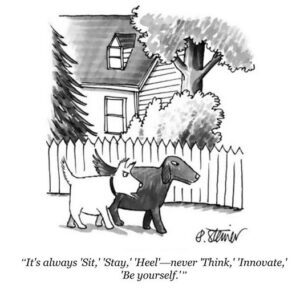
Who doesn’t want to understand their cat, dog, horse, or guinea pig better? Who doesn’t want to have a deeper connection to their companion animals that we share our homes with? This is a popular, unusual and exciting gift to give any animal lover.
Learn more about Animal Communication for your dog, cat or other pet here.
Purchase your Animal Communication Sessions here: PayPal.me/LoriRobinsonConsults
I love offering this. Each year it feels so nice to hear the excitement and thrill of the person who has received the gift, especially when they have never received an animal communication reading for their pet before. The receiver of the gift is super appreciative, although maybe a bit unsure at first, and always amazed by the accuracy and information they get about their animal companion.
Best Gifts for Animal Lovers #2If an Animal Communication session is not your thing but you are still wondering what to give a friend who is an animal lover, my book, Saving Wild, with a forward by Jane Goodall may be the perfect present.
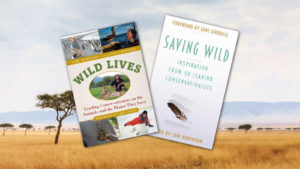 It’s a small, inspiring read for anyone concerned about the state of the planet and all its wild beings. You can check it out, read wonderful reviews, and purchase it on Amazon.
It’s a small, inspiring read for anyone concerned about the state of the planet and all its wild beings. You can check it out, read wonderful reviews, and purchase it on Amazon.
Best Gifts for Animal Lovers #3
For those people on your list that love wildlife my book, WildLives, tells the stories of twenty wildlife heroes devoted to saving elephants, giraffes, lions, penguins, gorillas, cheetahs, and more. You can also find this book on Amazon or contact me at lorisavingwild@gmail.com for a signed copy.
Happy Holidays to you, and all the animals in your life.
The post Best Gifts for Animal Lovers This Season appeared first on Saving Wild.
March 23, 2023
Sit Spot Practice
One of my favorite ways to deepen our connection to nature and animals is through a ‘sit spot’ practice. I first learned about this method from author Jon Young, and it has truly changed my life.
He uses the exercise to focus on bird language. But I’ve tweaked his method to give it a broader focus. My sit spot practice focuses on our connection to all of the natural world.
I’ve been doing this simple but profoundly rewarding activity for the past few years and I think you will love it as much as I do.
How To Do Your Own Sit Spot Practice1) Find a place where you can sit close to Nature – to trees, shrubs, and/or smaller plants. Your chosen place can be in your garden, a park, the woods, or on a balcony – anywhere that you can get to easily and quickly on a daily basis. The only criterion is that you have a view of the Natural world.
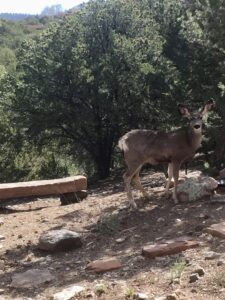 My first Sit Spot was a bench I put in my back garden in Santa Fe, NM a few years ago.
My first Sit Spot was a bench I put in my back garden in Santa Fe, NM a few years ago.
2) Once you find your spot in Nature, the idea is to visit that place alone as often as possible. Daily is ideal. I can be found every morning with a cup of tea in my sit spot. Since perfecting my practice and moving homes a couple of times, my sit spot areas have changed. But in general, you want to pick one area for at least a year.
To see what my current sit spot looks like, check out this one-minute video on my lorisavingwild YouTube channel.
3) Sit still and quiet for at least 15 minutes (the longer the better). Turn off your cell phone, and adopt an open, mindful, present attitude. It is similar to mediation except your eyes are open and you are fully engaged. Paying attention to all of your senses notice what is happening in the Natural world around you. What do you hear, what do you smell, what do you feel, what do you see, and even what do you taste? Just notice and pay attention. For instance, you may feel the wind, hear a bird, see a chipmunk, smell a fragrant flower, and notice a taste in your mouth. Just take notice. There is no need to define, label, figure out, or do anything except be fully present to all your senses and what they are picking up from the Natural world around you.
At first, you may simply notice things that stand out more than others – loud sounds, movements, large plants, or trees. But with time and consistency, your awareness will deepen. You will get to know the resident animals from the ones passing through, you will see how different plants respond to weather and seasonal changes, and you will learn the language of the birds and other wildlife. Over time your awareness will transition from a wide general view to a more intimate micro worldview. And you will become a part of the environment. The birds will no longer flee, the wildlife will accept you as part of the landscape and you will feel a sense of belonging and being in partnership with all life around you.
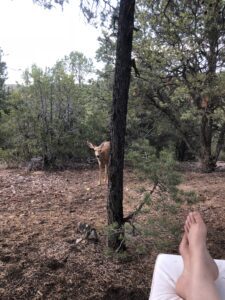 Over time the wildlife accepts you as part of their environment. This is my 2nd sit spot area.
Over time the wildlife accepts you as part of their environment. This is my 2nd sit spot area.
I said earlier that this practice has changed my life. I feel less alone knowing I’m connected to the natural world and am a part of it. I am more grateful and in awe of the beauty in the world, and more in tune with my senses even when I’m not in my ‘sit spot’.
Because I use my sit spot practice in the mornings it gives me a wonderful start to my days. Although I still have a meditation practice as well, I’ve noticed that on some days my sit spot practice feels like an extension of, or additional time spent, meditating.
Being fully present on a consistent basis is how we best build and deepen our connection to all the wonders of Nature and the ‘sit spot’ practice is one of the simplest and best ways to do this.
The post Sit Spot Practice appeared first on Saving Wild.
March 6, 2023
Donating to Animal Charities: What you Need to Know
I have a Senegalese friend who now lives in the USA working as an African drummer. Every morning Bara walks along the streets of Los Angeles purposely seeking a homeless person. When he finds that person, Bara reaches into his own pocket and hands out one of the few dollars he possesses.
When I ask Bara, “Why do you do that every day?” his answer is simple.
“I have to,” he says.
Tithing or sharing the ‘wealth’ (even when you are not wealthy) is a cultural expectation among everyone I have ever known from Africa.
Americans are also generous. We are one of the most philanthropic of all nations. That’s a great thing but what I find surprising is most of the money given to charity does not come from the people who have the most wealth.
My friend Lynn Twist, author of The Soul of Money would not be surprised by Bara’s actions. She says that the majority of the donations come in small amounts – one, ten, fifty dollars – from people with the least amount of wealth because giving, on any level, feels good.
Another surprising fact is only 2 cents of every American donor’s dollar goes to donating to animal charities. This tiny amount includes gifts to humane societies, zoos and climate change organizations.
Yet now, more than ever, our generosity is required by organizations saving wildlife and wild places. Scientists say we are entering the sixth mass extinction event, losing more species at a faster rate than at any time in human history. (That fact was the catalyst for my both my books – Saving Wild: Inspiration From 50 Leading Conservationists. and Wild Lives.
In the forty-plus years I’ve been working with wildlife non-governmental organizations I’ve never experienced such an important and pressing time for donating to animal charities.
Donating to Animal Charities is not always effective.
For instance, how do you know which organizations you donate to are successful in saving wildlife? How do you know they aren’t wasting your money? Charity Navigator tells only part of the story of the organizations it covers, and those organizations are based only in the USA.
I’ve made it easy for you for donating to animal charities by finding some of the best, most effective non-government organizations (NGO’s).
You can check out my list of my favorite 40 organizations saving wildlife and wild places across the world. All are highly respected NGO’s in their field. Many I have worked with, and donated to personally and/or through Saving Wild.
Never doubt that you are needed. It’s not enough to share shocking Facebook photos. They fuel the appalling side of conservation. Rather, it’s important to focus on the positives. To get engaged. To support wildlife NGO’s by donating and becoming active and involved with them.

The simplest way of donating to animal charities –
Let Saving Wild vet the organizations for you and put your generous gifts where they are needed most.
Donate to SavingWild.com and I will pool your money with other generous donors and divide it among favorite wildlife NGO’s that are the best at helping animals.
No amount is too small. Give yourself the gift of giving and quit wasting your generosity.
Donating to Animal Charities could not be easier. Use this link to make your donation through Saving Wild now:

The post Donating to Animal Charities: What you Need to Know appeared first on Saving Wild.




